The Basic Principles Of Best Basement Waterproofing
Table of ContentsSome Known Questions About Best Basement Waterproofing.Getting The Best Basement Waterproofing To WorkBest Basement Waterproofing Things To Know Before You BuyWhat Does Best Basement Waterproofing Mean?Not known Facts About Best Basement Waterproofing
uses excavation techniques toward all-time low of the framework's foundation. involves eliminating wetness after it has actually entered the basement. AdvantaClean's trained specialists and technicians will locate the water source. If wall or slab fractures are present, we will inject polyurethane and epoxies right into the splits and secure the concession, protecting against further moisture from going into.Installing cellar air flow systems, conditioning systems, or basement dehumidifier systems to obtain water out of your basement. Selecting AdvantaClean's basement waterproofing services is an effective way to deal with moisture and prevent mold from compromising the framework of your home and the wellness of your household.
If there's condensation on the outside of the foil, you have high humidity in your cellar. If the foil has condensation on the within surface area (next to the wall), the soil around your residence may be naturally damp from a high water table or bad soil drain.
You can waterproof simply your indoor walls, which might fix the issue. Or you can waterproof your outside walls, which is a much better wager but even more costly. Below's the inside story on the various kinds: These thick coverings are cement-like. Once they dry, they stick permanently to concrete and stonework walls.
The 5-Second Trick For Best Basement Waterproofing
Concrete water resistant coverings can't be used to formerly painted surface areas; check the tag. Recognized as densifiers, they are appropriate just for wall surfaces that have not been repainted or secured.
You clean, roll, or spray it on much even more thickly one gallon covers simply 75 square feet, not the 300 square feet regular with basic paint. Water resistant paint is fine for DIY application. You can apply it over repainted surface areas, and paint over it once it's healed (one gallon expenses $37).
It can cost $10,000 to $15,000, depending on the work needed (Best Basement Waterproofing). Outside waterproofing entails digging deep into all around the home to the complete depth of the structure walls, after that installing a waterproof coating or membrane topped by drain panels.
Little Known Facts About Best Basement Waterproofing.
A basement without waterproofing is kind of like that. Your basement does not want to go with a rainstorm without appropriate security just as much as you don't want to.

Outside waterproofing is a waterproofing method that includes sealing your home from the exterior. It's kind of like a moat around a castle. It includes excavating a trench around your entire home down to the foundation (about 8 to 10 feet down). The foundation walls are after that cleansed, sealed, and covered with a waterproof membrane layer or sealant.
How Best Basement Waterproofing can Save You Time, Stress, and Money.
It's a more involved process that needs excavating up your lawn, which is expensive and lengthy. Outside waterproofing includes removing whatever surrounding your house, Related Site including patios, driveways, pathways, landscape design, air conditioning units, decks, and more. If any of the job was done inaccurately and water is still entering your basement, there isn't much you can do to correct or repair it.
Interior cellar waterproofing involves waterproofing from the within. Any water that leaks right into your basement is rerouted prior to it touches your floor.
It's an effective technique to waterproof your basement. The downside of indoor basement waterproofing mainly has to do with the installation process. This method needs saved items, furniture, and integrated shelving or cabinets to be moved from touching the cellar wall surfaces. And during setup, your cellar can't be made use of. The most significant distinction between the two techniques is this: Outside waterproofing is a preventative solution and indoor waterproofing is a rehabilitative solution.
Not known Facts About Best Basement Waterproofing
Finally, outside and interior basement waterproofing are both reliable approaches of shielding your home from water damages. Outside waterproofing creates an obstacle that prevents water from entering your home, while indoor waterproofing redirects water that does enter your home. And it is necessary to keep in mind that exterior waterproofing is a pricey and turbulent installment process when compared to indoor waterproofing.
Whichever approach you pick, make sure you pick a reputable and credible specialist for the task. Both techniques require Visit This Link skilled employees to take care of the task. If you have any questions concerning cellar waterproofing, please get to out to us. And if you're in our solution area and have water in your cellar, contact us for a free, no-obligation home inspection.
You can fill out our kind here. Best Basement Waterproofing, begin a chat in the lower right-hand corner, or call us at 1-800-827-0702